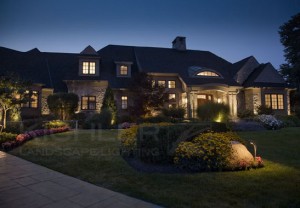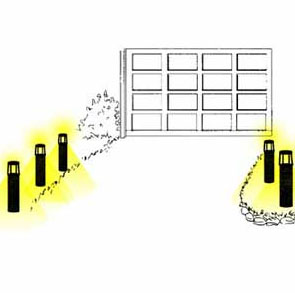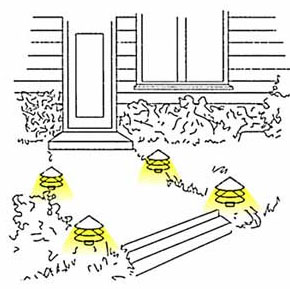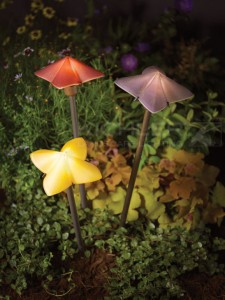Putting You On The Right Path
It’s Saturday night and you’re arriving home after dinner and a movie. You forgot to turn on the outside light and you suddenly notice how dark everything looks. It’s clear that nobody is home. How safe are your house and possessions when you’re not there?
Lighting the exterior of your house and/or garden is a great way to enhance both the safety and beauty of your home environment. If you’re intimidated by the idea of landscape lighting, don’t be. Just grab a piece of paper, go outside to take a look around, and jot down a few notes.

A great example of a well-lit exterior.
1. Decide what areas or features could – or should – be illuminated. Your front doorstep or porch probably already has an exterior fixture, but what about the path to the door? How about the driveway? Are there multiple entrances? Lighting the most frequently-used entry path is a good place to start.
If you have a garden, step back and assess some basic features. Is there a stand of trees that would benefit from uplighting? Do you have a dramatic feature such as a fountain or pond languishing in the dark? Uplighting a tree or water feature adjoining the entry path is a great way to add functional ambient light and spotlight a beautiful garden feature at the same time. A trellis or archway looks spectacular at night with some simple uplights. Be cautious not to over-do it – in most cases, more landscape lighting is not necessarily better.

Steps, paths, and driveways lights are simple to install and can easily be moved to reflect changes in your landscaping. Low-level path lights can also be used to define the boundaries of long driveways. Bollards or cut down pole lights which stand 30 to 36 inches off the ground also work well.

For added security, illuminate any side of the house that would otherwise be in shadow. To conserve energy, install a wall timer, a motion or heat-sensitive control that will switch on the light only if someone approaches that side of the house.

You can install path lights or post lanterns or attach lights to the side of your house. Low-level path lights, which spread circular patterns of lights, will brighten your walkway, while highlighting nearby flower beds, shrubs, and ground cover.
2. Choose the lights. The variety of landscape lighting is staggering. How do you decide what the right fixture is? Should you use 12 volt, 24 volt or 120 volt? The first step is to select the lighting that creates the aesthetic look you desire.

Kichler Posies – Path and Spread Lights
Landscape lighting can either be a focal point or can blend into your landscape. Today, with so many beautiful landscape lighting designs, you may want to highlight some fixtures while making others disappear. The key is to use the effect of the lighting to enhance the beauty of your landscape. Think of landscape lighting as a way to paint a picture with light. If you can imagine it, in most cases, we can do it!
3. Purchase and install your selected lighting. Once you know where and what you’re illuminating, talk to the experts at Connecticut Lighting Centers. We can help you achieve your desired effect by selecting the right fixture for the right application. We will advise you on the number of lights and other supplies you will need, including a transformer and cabling. During your consultation, we will explain how to choose the appropriate voltage depending on a variety of factors specific to your home.
Explore our online product search for ideas or come into the Connecticut Lighting Centers showroom to see our tremendous display and inventory of the latest landscape lighting.
